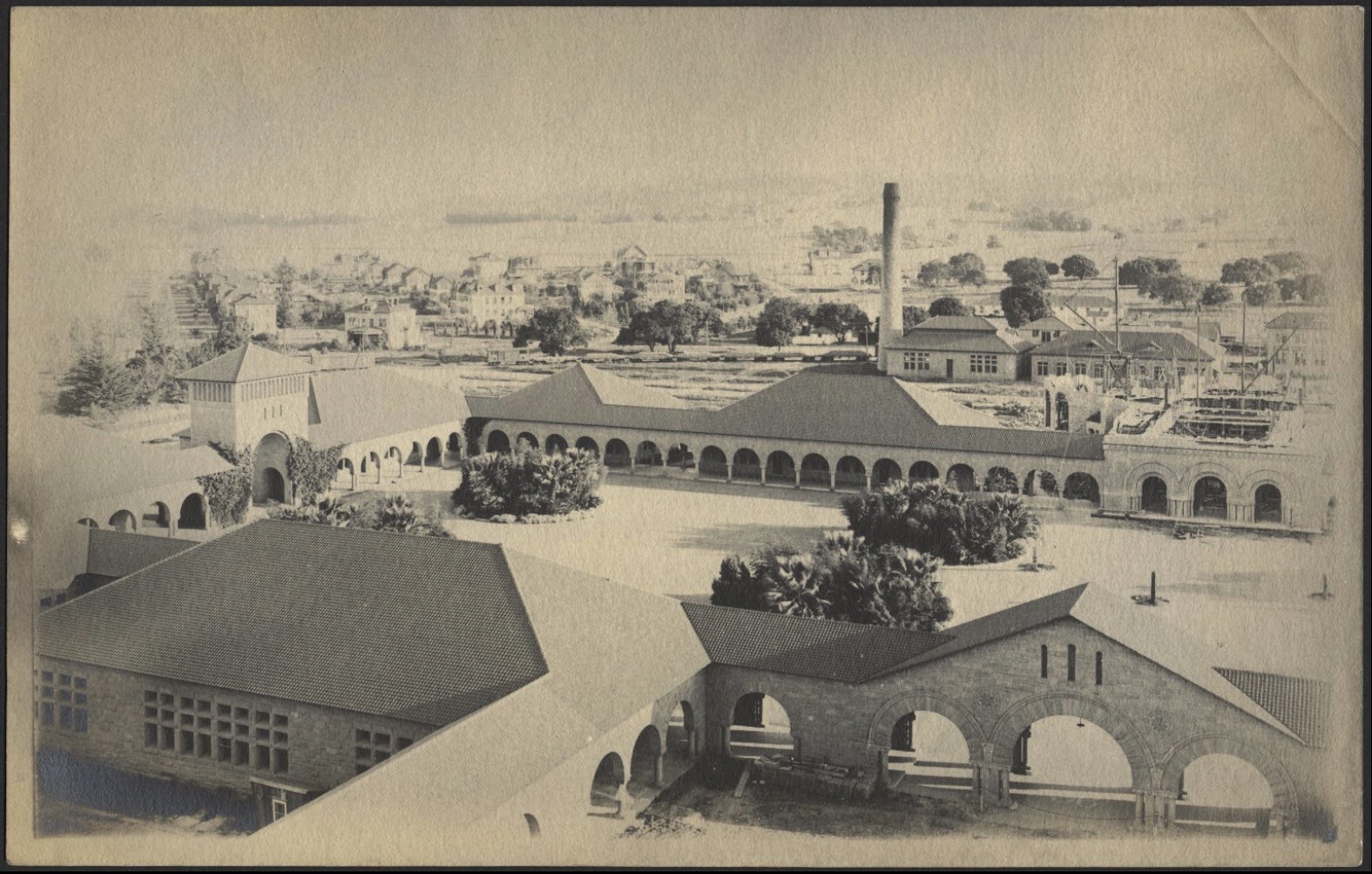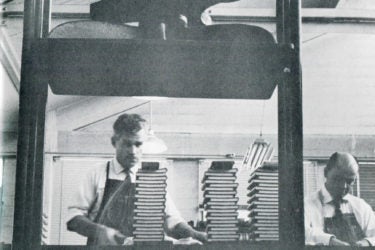About a year after Stanford University opened its doors in 1891, then-sophomore Julius Andrew Quelle set up a one-man printing shop inside the university’s powerhouse near the Main Quad.
A 22-year-old New Yorker who spent his pre-college years working for a printing and bookbinding company, Quelle borrowed $25 from each of the university’s 12 professors to purchase a small secondhand press. He was encouraged by his classmates to start printing the first editions of the student-run newspaper, the Daily Palo Alto, today known as the Stanford Daily.
There, in a cramped, one-story building with a tall stone chimney, next to boilers and generators, Stanford University Press was born.

A photo from the 1890s shows the powerhouse – the building with the chimney – where Julius Andrew Quelle, then a Stanford student, set up his printing shop initially. (Image credit: Stanford Historical Photograph Collection, Stanford Department of Special Collections and University Archives)
In addition to printing the student paper, the press also began producing publications by Stanford faculty and community members.
This fall, the university press celebrates its inception and 125 years since the first book was published by the university in 1892.
Legacy of publishing
Since publishing that first book, the university press has printed close to 6,000 books, of which about 3,500 are still in print and available for purchase, said Alan Harvey, director of the press. Today, the press produces about 140 books per year by faculty at Stanford and around the world in the fields of the humanities, social sciences, law and business.
The press is among the oldest academic presses in the United States, which include those at Cornell University and Johns Hopkins University. It was also the first university press to be established on the West Coast.
“The rediscovery of our own past has offered remarkable opportunity to celebrate a legacy of quality publishing and innovation,” Harvey said.
That first 1892 book, The Tariff Controversy in the United States, 1789-1833, was written by Stanford’s first registrar, Orrin Leslie Elliott. It explored the history of tariff policies and their surrounding debates in the early days of the country. The 272-page work was part of a series of research publications that Stanford’s first president, David Starr Jordan, envisioned the university would produce as part of its mission to democratize education and widen public access to knowledge.
Upon accepting his post as Stanford president, Jordan, an avid supporter of academic presses, asked university leaders to devise a plan of action that would allow for “publication of the results of any important research on the part of professors, or advanced students.”
At first, Quelle didn’t have the necessary tools to publish and bind the kinds of lengthy academic books Jordan envisioned. The 1892 book had to be published at a press in San Francisco. But Jordan encouraged Quelle to continue his on-campus printing efforts.

David Starr Jordan, Stanford’s first president (Image credit: Stanford University Archives)
“Dr. Jordan told me the university would always need a printing office. … Dr. Jordan had the greatest mind I ever knew.”
—Julius Andrew Quelle
“Dr. Jordan told me the university would always need a printing office but had at that time no funds that could be used for that purpose,” Quelle wrote in a 1950 letter, describing the history of the press. “He wanted me to continue what we had, and to expand as we could, and that he would [do] what he could personally. … Dr. Jordan had the greatest mind I ever knew.”
In 1895, Quelle’s Stanford-based press printed the first publication with the “Stanford University Press” imprint – The Story of the Innumerable Company by David Starr Jordan.
Several moves
Quelle’s press team eventually outgrew the powerhouse and moved their office into a 40-by-40-foot building Quelle built with his brother-in-law in the late 1890s on the spot where Old Union now stands.

A 1906 photo shows the building Julius Andrew Quelle built to house his printing shop. Old Union now stands on the same spot. (Image credit: Stanford University Press Archives)
“Were it not for Jordan’s vision and Quelle’s industriousness, there may not have ever been a Stanford University Press,” said Kalie Ann Caetano, a digital media specialist at the press who has spent the past several months piecing together a detailed history of the press. “Yet, 125 years later, the publishing house that got its start in the campus powerhouse is still going strong, supporting and refining scholarship that both extends and challenges prevailing views and disseminating new knowledge of all types around the world.”
In 1917, Stanford bought Quelle’s printing shop for $9,500 and opened a new press building, spending thousands of dollars more on new equipment.
After that, the press continued to expand, taking up a big chunk of the land east of Lomita Mall, between Santa Teresa Street and Panama Mall.

A 1929 photo of the Stanford University Press team in front of their building. (Image credit: Stanford University Press Archives)
By the 1920s, the press gained its first editor, William Hawley Davis, who was a professor of English at Stanford, as well as a team of designers, typists, proofreaders and printers. In the 1930s, the press was one of the first to incorporate then cutting-edge photo-offset printing.
The printing plant reached its heyday in the 1950s and 1960s, producing about 150,000 copies of books per year, in addition to printing the Stanford Daily and various other university publications.
Throughout those years, the press was praised with numerous awards for the quality of its work, including accolades for its design efforts and bookbinding.

Image credit: Stanford University Press

Image credit: Stanford Historical Photograph Collection, Stanford Department of Special Collections and University Archives

Image credit: Stanford University Press
See all 8 photos

Image credit: Stanford University Press

Image credit: Stanford University Press

Image credit: Stanford University Press

Image credit: Stanford University Press

Image credit: Stanford University Press
In 1976, the university decided to close the printing plant in order to save money. However, the publishing house remained and has continued to evolve, becoming especially well-known in academia for publishing impactful work in the areas of continental philosophy, Latin American history, Asian studies, Middle Eastern studies and Jewish studies from scholars around the world.
The press’s editorial team has embraced innovation – experimenting with different publishing formats, printing shorter research books and a few fiction works. The team is also currently pioneering a unique digital publishing program, funded by a grant from the Andrew W. Mellon Foundation.
“As we celebrate our 125th anniversary, the press is focused more than ever on innovating new publishing practices to better serve the scholarly community,” Harvey said. “We are excited about what the future holds.”
Today the press’s team of about 35 people is temporarily housed in a building in Redwood City while waiting for their new home to be completed as part of Stanford’s Redwood City campus.
The only part of the former press facilities left standing today on campus is a building that used to serve as a book warehouse and shipping room. It now serves as office space for University Communications – including Stanford Report – and the Office of Special Events and Protocol.
Media Contacts
Alex Shashkevich, Stanford News Service: ashashkevich@stanford.edu, (650) 497-4419
Author
Alex Shashkevich